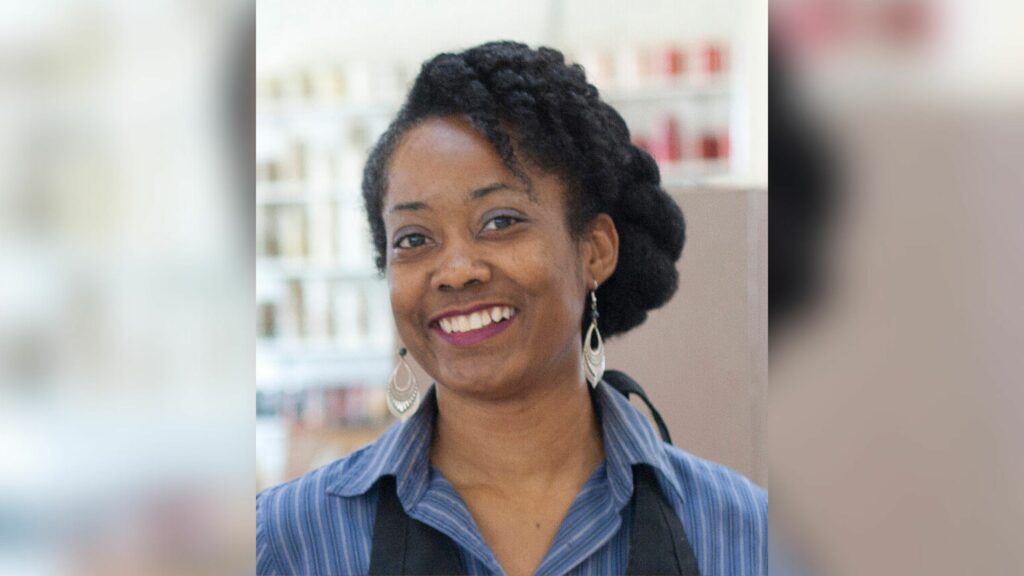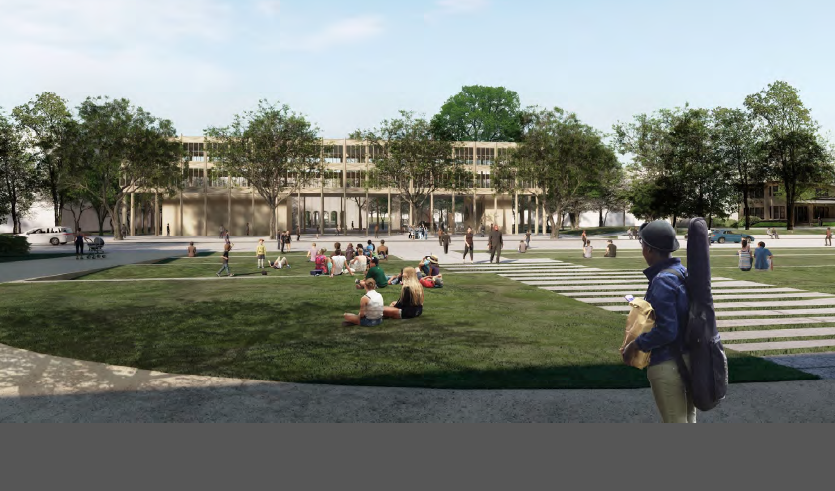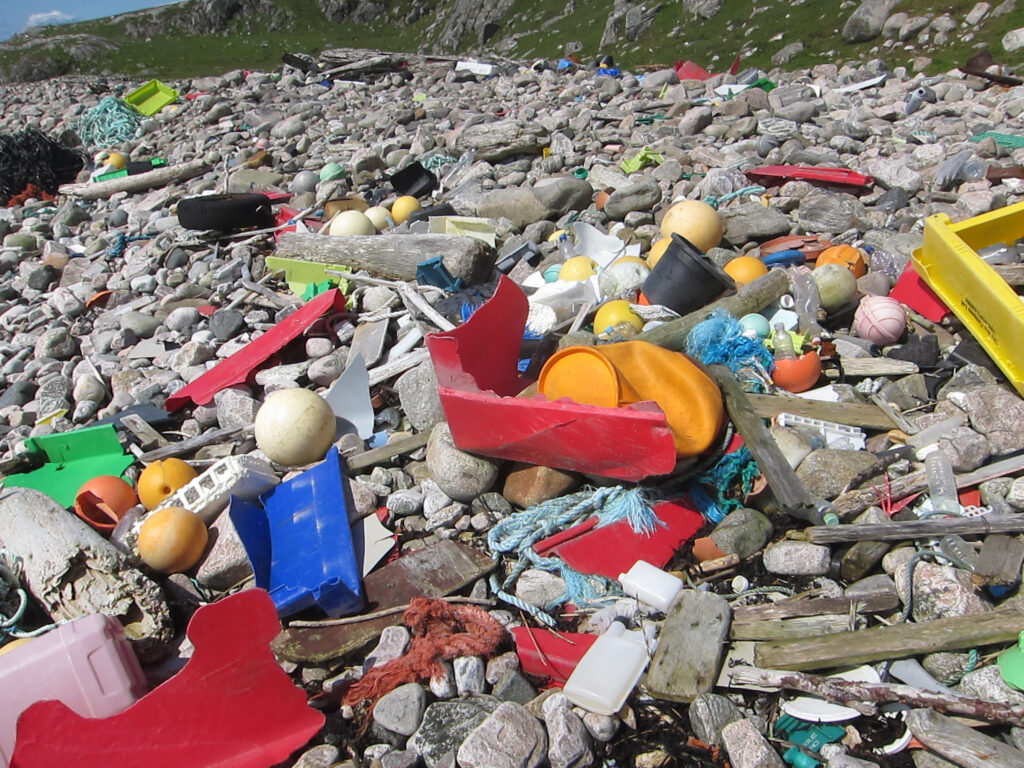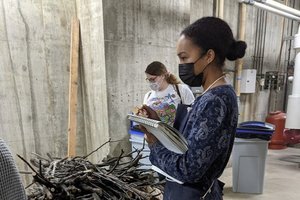Becoming Sustainable in a Water-Intensive Business

In 2013, industrial designer Shayla Johnson launched Scarlet Crane Creations and began selling her stationery and other prints at The Rust Belt Market in Ferndale. She quickly realized her disdain for using paper as a medium due to the waste it created. Pivoting to natural and organic fabrics and eco-friendly inks, she created her Detroit Collection which includes home décor and accessories made from original and sustainable hand-printed fabrics. Over the next eleven years, she progressed her sustainability practices and is now revamping her systems, equipment, and space toward the preservation of water and the support of using organic dyes and materials. SBN Detroit interviewed Johnson about the impetus behind her vision, the challenges in executing sustainable practices in the print and textile industry, and the solutions she is employing. Q: What is the company’s approach to sustainability? A: Sustainability is always a thread in my thinking and I’m always looking for ways to do better. I’ve progressed from paper to fabric to more responsible fabric and continue this evolution. I use all organic and eco-friendly inks. We are also focused on a closed-loop system that allows us to recycle the water we use. Q: What inspired you to focus on your water usage, and what are the challenges in the printing/textile industry that you face regarding this? A: At one point along the way I measured how much water I was using in one print session, and it was ten gallons. To put this in perspective, that involved dying about ten to 15 yards of fabric. I saw this as completely problematic, watching all that water go down the drain. And began to think exponentially – what does this look like across the country and globe? I have come to find out that the global textile industry utilizes 1.3 trillion gallons of water annually – enough to fill 2 million Olympic-sized pools. Q: What did you do next? A: Water-based inks have always been my focus. I knew that going forward when I dump the waste, I needed to make sure it was filtered and disposed of properly and the water was reused. I began working with Centrepolis, and they connected me to Dr. Refael Aharon, an expert in textile recycling. We worked for four months studying my processes and developed a system that he outlined for me including recommendations and the equipment and type of space I will need. Q: You recently won a $10K grant from Michigan Women Forward to expand your space to accommodate this. What has this involved? A: That’s right. I am part of the Motor City Match program now and am in the development track, where I’m getting help to further plan the space and secure a location. Q: You utilize fabrics that are sourced in the U.S. and the production is focused locally in Detroit. What challenges come with this? A: The companies we order from are all American-based companies, and it is all organic cotton and linens, etc. But there are very few mills in the U.S. these days, so some of the raw goods are unfortunately imported. The companies we buy from all have a commitment to sustainability, and I try to purchase as much fabric as I can locally. Our bread-and-butter product – tea towels – is from a fabric company in Michigan. Q: What are the challenges in working with organic inks and dyes? A: Using natural dyes requires a different process that is more labor-intensive and therefore takes longer. These dyes are made from plants and proteins that come from cactuses and other natural sources and can be more expensive to source. Since they are all-natural, they don’t last as long. We have to use them faster and that can be tricky to manage. So, the biggest barrier becomes being able to produce in a way that still allows us to sell the products at a reasonable price. However, my clients appreciate and seek out these products purposefully, choosing not to purchase ink that requires solvents and materials made of synthetics, etc. So, they are not surprised by higher price points. This model aligns with slow fashion – being thoughtful and intentional about the outcome even if that takes longer. I believe in having an item that will last longer and that won’t end up in a landfill. Q: Are there additional sustainability practices you deploy? A: Some of our items are created from upcycled materials like jeans and pre-owned items. People also like these because they are one-of-a-kind. Q: In terms of sustainability – does your location in Detroit come into play? A: Yes. Because there has been a resurgence of interest around Detroit and people are looking to focus efforts in this area, that has helped. People want to support us. My assistant is a College for Creative Studies graduate, and I want to continue to train students locally who have a passion for fibers and sustainability around textiles. I want to keep all of that within the Detroit ecosystem. Q: What are the barriers you have faced operating sustainably as a smaller company? A: The inability to work as quickly as we’d like. Also, the dyes I mentioned. Some only last two to three weeks, so we try to print as much as we can in a few sessions before the vat goes bad. Organic materials can be unstable. You constantly must keep them fresh. Q: What is your advice to other design/textile companies like yours when it comes to sourcing locally to help the economy and be more sustainable? A: I believe in collaboration, especially with local schools and universities. I think sticking to a local pipeline of talent is important. I work as an adjunct at CCS, and it’s really been useful to me to bounce ideas off of others. My advice is to never work in a silo – build a community. To that end, I belong to a couple of community printmakers in the area and have been deeply
Connecting Detroit Institutions to Create a Sustainable Hub

Midtown Detroit Inc. (MDI) recently received a $12 million appropriation from the State of Michigan that will be used to support the Cultural Center Planning Initiative – a strategic effort to reinvent the public space that connects 12 cultural organizations across an 83-acre site. The collective goal is to create a more vibrant, connected, accessible, and sustainable district for future generations including stormwater infrastructure solutions, new parking with EV charging stations, safer pedestrian experiences, beautiful landscaping, lighting, diverse public art, free public Wi-Fi, and programming. The institutions include The Carr Center, Charles H. Wright Museum of African American History, College for Creative Studies, Detroit Historical Museum, Detroit Institute of Arts, Detroit Public Library, Hellenic Museum of Michigan, International Institute of Metropolitan Detroit, Michigan Science Center, The Scarab Club, University of Michigan and Wayne State University. SBN Detroit interviewed Susan Mosey, Midtown Detroit’s longtime executive director, to find out more. Q: How did the $12 million from the state come to be? A: We lobbied hard with the DIA and Science Center and all the institutions collaboratively. We took multiple trips to Lansing to sell the vision to legislators and the appropriations chairs. Ultimately, I think all parties understand that this combined collaborative vision will have a big impact on Detroit and the state of Michigan. The time is right for executing a bold visionary plan and creating a more compelling arts and culture experience for visitors and residents. Q: What is the impetus behind creating this cultural hub? A: We have a great set of institutions that sit side-by-side that have never been connected. Each offers tremendous assets and programming and a broad demographic of visitors but until now, there has not been an intentional strategy to unite and connect all of them and offer a vibrant and thriving cultural destination. This initiative will allow us to use the entire set of institutions to drive visitors and provide more holistic programming and services. We will be able to market this full footprint, not the singular institutions as has been done in the past. The initiative also inherently offers the opportunity to create new opportunities for sustainability. Q: To that end, how important is incorporating sustainability in this project? A: It’s huge. It’s an integral and foundational aspect in all of the thinking, planning, and execution. We have secured a team of architects, landscape architects, and environmental engineers including Ann Arbor-based Akoaki Architecture, Agence Ter out of Paris, and Drummond Carpenter. Each of them focuses on sustainability as a priority. This will play itself out in many ways. One tangible and immediate example is stormwater management. This area has suffered significant damage due to flooding, so this is a top priority, and we are working with the city on this already. Managing stormwater with new infrastructure and design will help mitigate flooding, but also lends to redeveloping our streets and landscaping toward sustainability overall. The first phase of the project will result in an expansion of the existing tree canopy with 136 new trees. Q: What about accessibility and walkability? A: Currently it’s a challenge to navigate between institutions. The layout does not facilitate a holistic experience. So, we’ll incorporate wayfinding and are looking at how to create walkways that facilitate a better experience. The width of streets will be reduced to increase greenspace and walkability. The surface parking behind the DIA will be converted to a large green space. The first phase includes a state-of-the-art underground parking garage that will include charging stations, ADA accessible, and more. Q: What are the economic impacts for businesses in the area and the area as a whole? A: Overall, we expect more foot traffic for restaurants, retailers, and such in the area. Further, there are a lot of undeveloped spaces and vacant lots that will be more marketable for development for new businesses to come in. I see the opportunity for more foot traffic downtown as well since people travel between midtown and downtown frequently now that the M1 rail is free of charge. Q: Is there a job creation aspect? A: I think creating this vibrant space means everybody benefits and we should see continued job growth within the institutions. Also, potential new development in the area points to more opportunities for this. Q: Is there a recruiting aspect in terms of bringing more professionals into the city? A: Yes. We know that companies care about arts, culture, and education. Offering easy access to these resources and experiences makes any city or place stronger and more desirable to live and work in. We have not done enough to get the word out about our collective resources. So, I think creating this vibrant space with enticing programming and walkability will be impactful. Q: What does the first phase look like – when can we expect to see what’s different and what will that be? A: The new state-of-the-art underground parking deck will replace the abandoned parking lot in that area. It will service all the institutions and be open to the public and accessible to all. Phase one also includes the stormwater management system and landscaping. Ultimately, we’ll focus on this zone and use it as a pilot to be repeated in other parts of the district. Q: You’re retiring from your job at the end of the year, and your leadership has been pivotal to Midtown’s evolution. What are you personally most proud of? A: Establishing a large number of both national and local historic districts and preserving dozens of historic properties up and down the Corridor many of which were threatened by neglect or fire. Be sure to subscribe to our newsletter for regular updates on sustainable business practices in and around Detroit.
College for Creative Studies Launches Graduate Program Toward Developing Leaders in Climate Action

In the fall of 2023, the College for Creative Studies will launch Design for Climate Action – a new graduate program aimed at tackling the global climate action and change emergency from multiple angles. The program invites applications from designers and non-designers of all kinds, bringing together broad multidisciplinary mindsets for interdisciplinary collaboration. It will foster an understanding of zero-waste materials and processes, circular economies, civic infrastructures, and environmental stewardship. At its heart is the drive to bring about change in existing systems and transition to structures that reverse global heating and uphold climate justice and global equity. Leading the program is Dr. Ian Lambert, Dean of Graduate Studies & Research. Lambert is a designer and maker-researcher with extensive experience in academic leadership and curriculum development in higher education in the U.K., the U.S., and China. Lambert has taught sustainable design for more than 20 years and his work with ocean plastic in Scotland along with other waste streams is widely published. He has brought his work with ocean plastic to the Great Lakes and recently joined the Detroit River Coalition. For the last two years, he has been collaborating with the Charles H. Wright Museum of African American History on the d.Tree Studio – diverting dying trees from landfills to become narrative artifacts that elevate climate justice. He is a Fellow of the Royal Society of Arts, and a former advisor to the Creative Conscience Awards. SBN Detroit spoke to Lambert about the program. Q: What is the impetus behind the new Design for Climate Action Master’s Program? A: In addition to further embedding sustainability across the CCS curriculum, we are looking to highly specialize in addressing the climate crisis. This is about working toward and educating about systemic change. There are many perspectives required in tackling climate action, so the program is about foregrounding design thinking at the intersection of multiple disciplines. The program welcomes scientists, engineers, philosophers, and sociologists as well as designers and other creatives. It is the synergy formed by these different skill sets that can drive change in the climate crisis. It’s important to remember that while science presents the facts and explains what is happening, the climate crisis is a cultural crisis, a social crisis, an economic crisis, and a political crisis. It affects humankind in many different ways and it’s not just for scientists to solve. The program takes the position of stating climate problems calmly and rationally. We need to use intelligent and persuasive narratives to bring others, including business leaders and politicians, with us. The debate is often highly polarized, which is dangerous. So, it is important to temper our outrage and avoid alienating those across the divide. Q: What does it mean for CCS to offer this program? Is this kind of curriculum unique to design school offerings? A: The program is focused on action in the climate crisis and systemic change. I don’t know of any other program that takes such a multidisciplinary approach with design at its hub. Also, our grad program is growing, and part of our strategy is to consider where the needs are and identify opportunities for aligning with the activity that’s happening in Detroit. Essentially the program has three pillars that overlap and blend: The circular economy and closed-loop manufacturing and material cycles. Systems and infrastructures – How we can redesign these or make interventions and design out waste? Environmental stewardship and understanding the lasting effects of human production on our environment Q: What implications might this have for the Detroit businesses – graduates with this skill set and education coming into the workforce? A: A recent report in the Atlantic stated that the government will be spending $374 billion on fighting climate change, and some are estimating it will reach $800 billion. This will require experts of all kinds to implement and lead change within businesses, corporations, and public organizations. Experts who can galvanize collaboration and take action in multiple ways. The demand for climate design experts is only going to grow, and our graduates will go into the world with not only the expertise but the passion and capability to apply a persuasive narrative to bring about these changes. Q: Can you tell us more about bringing together broad multidisciplinary mindsets for interdisciplinary collaboration? A: At the graduate level all design programs operate at disciplinary intersections. The climate change crisis is omnipotent, and the key to this (working to solve it) is being capable of working with other areas of expertise. This is not a crisis to be dealt with by lone crusaders. It truly requires collaboration that is deep and expansive. So it’s really important to develop students into leaders who can advance this approach. When it comes to leadership, there is this concept of the T-shaped individual, where the vertical bar on the letter T represents the depth of related skills and expertise in a single field, and the horizontal bar is the ability to collaborate across disciplines with experts in other areas and to apply knowledge in areas of expertise other than one’s own. And then there are X-shaped individuals, with “executive” skills and deep expertise in a core knowledge area as well as strong leadership skills and credibility. We need both T-shaped and X-shaped skill sets to approach and address the climate crisis, and our program will work toward building these. Q: Will the students be involved in sustainability programs and projects in Detroit? A: CCS has an extensive and well-established set of partnerships and connections with industry and our students work on many sponsored and live projects. Currently, students are working with Consumers Energy to help implement EV charging services from a user experience perspective. Last year, our students worked with the Charles H. Wright Museum of African American History on redirecting dying trees from landfill to narrative objects. Our students have worked on clean air projects, food waste diversion, water security, sustainable tourism, and green mobility systems, to name a few. I’m also very proud of the CCS Color and Materials Design Students who
The Wright – Committed to Preserving African American Culture – and the Environment

At their best, museums champion the exchange of ideas and the enrichment of intellect. As such, the Charles H. Wright Museum of African American History approaches sustainability within the context not only of preservation but also of education. The museum is at the forefront worldwide in its effort to make the work of sustainability visible in museums so that everyone can see that they have a stake in—and can contribute to—environmental preservation. The Wrights’ sustainability efforts formally took hold in 2015 upon hiring Leslie Tom, as its Chief Sustainability Officer who relocated from San Francisco by way of Arizona. Tom’s background in Architecture andInformation Management with a focus in the future of libraries, archives and museum domains were a perfect match for being the Third Cohort for a mid-career Detroit Revitalization Fellowship through Wayne State University. Of her role at The Wright, Tom says “To have the opportunity to combine my experience in environmental history and culture with the methodologies of service design and architecture and apply them at one of the oldest African American museums in the world is a dream job.” She goes on to say, The fact that the museum has a Sustainability Officer on staff illustrates its dedication and commitment to sustainability at all levels. Few museums even have this role. Under Tom’s leadership, The Wright has become a frontrunner in sustainability within the museum field. In 2019, The Wright was one of five museums to earn The Sustainability Excellence Award from the American Alliance of Museums Environment and Climate Network. Tom values the regional sustainability network and so helped to co-chair the inaugural Detroit 2030 District’s first Venue and Museums Committee. Detroit 2030 District is a part of a national movement to create high-performance building districts by reducing the environmental impacts of building. Tom points to three main areas of focus regarding the museums’ current sustainability efforts. “First is working to expand the triple bottom line [people, planet, prosperity and programs] and do what museums do well – engage learners,” she says. She gives d.Tree Studio as an example. When dying Zelkova trees were discovered on The Wright’s campus, instead of sending them to a landfill, the museum partnered with the College for Creative Studies to create d.Tree Studio – an ongoing wood shop class to explore connections between design, African American material culture/history, and sustainability. Students use the dying trees to make everything from a decolonized chess set to a fully-functioning record player. Second, is the Climate Action Framework, which The Wright museum supports through a green think tank team of museum staff, landscape architects, urban planners, designers, and community engagement plans all addressing the social and technical aspects of lowering the carbon footprint. Third, is the museum’s green work around the African World Festival. “We’ve been doing exciting green work since 2015 that’s finally being operationalized and next year will be line items in the budget,” she says. “This will include things like bike valets, recycling and compost space, sharing information at the festival and more.” She goes on to say, It’s been so satisfying to see co-creation and adoption by my colleagues and their inclinations increase toward a green institution. No one person can do it alone, and having mother nature break down silos, we’ve got support and work to do from the top down and bottom up. Some measurable initiatives The Wright has been involved with over the past several years include: The Wright’s proactive response to the August floods of 2014and increasing rain events created a collaboration with the Michigan Science Center where the result was a November 2019 convening calledRipple of Impact. Over 200 people visited our Green Stormwater Infrastructures to taste, touch, see, smell, feel the water. The Wright effectively manages nearly 19,000 gallons of stormwater each year removing 50,000 gallons of stormwater permanently from the sewer system overall. See the Stormwater Hub for more info. The Wright is continuing this work by hosting the Green Museum Town Hall with our Learning and Engagement and Sustainability Departments. Please check our website for our Green Museum Town Hall in mid-November 2022. In 2015, the museum installed Variable Fan Drives (VFDs) so museum pumps and motors do not run 24 hours per day, 7 days per week. From this effort, The Wright reduced its utility bill by $30,000. Due to green efforts around the African World Festival, The Wright has seen a 5% waste diversion rate increase, repurposed 536 pounds of recyclable material, and diverted 387 pounds of organics from landfills. A strong commitment to sustainability among The Wright’s staff has led to a 400% uptick in recycling rates on the museum campus. Of doing this work in Detroit, Tom says, “As an outsider coming into Detroit, I can say that I haven’t found another city where so much consideration and multi-generational collaboration is happening. Between the local organizations, nonprofits, and businesses the best practices coming out of Detroit are very impressive. To be working within this environment has true potential for addressing our climate crisis collectively.” When asked what project she’s most proud of, Tom says the investment made in 2019 to laser scan the entire museum building. “We now essentially have a digital twin of the building stored in the cloud, so that when we collaborate with landscape architects and engineers to invest in energy-efficient systems and more, we can upload the specs and leverage the data on how best to take care of this institution.” What’s next for The Wright? Tom says their continued work on creating a green museum of the future. “We are convening conversations and setting new standards. It’s an exciting place to be.” In closing, The Wright’s President and CEO, Neil Barclay says, “Inaction affects us all. So join The Wright as we transform spaces, hearts, and minds to make room for a more equitable future here in Detroit.” Be sure to subscribe to our newsletter for regular updates on sustainable business practices in and around Detroit.


